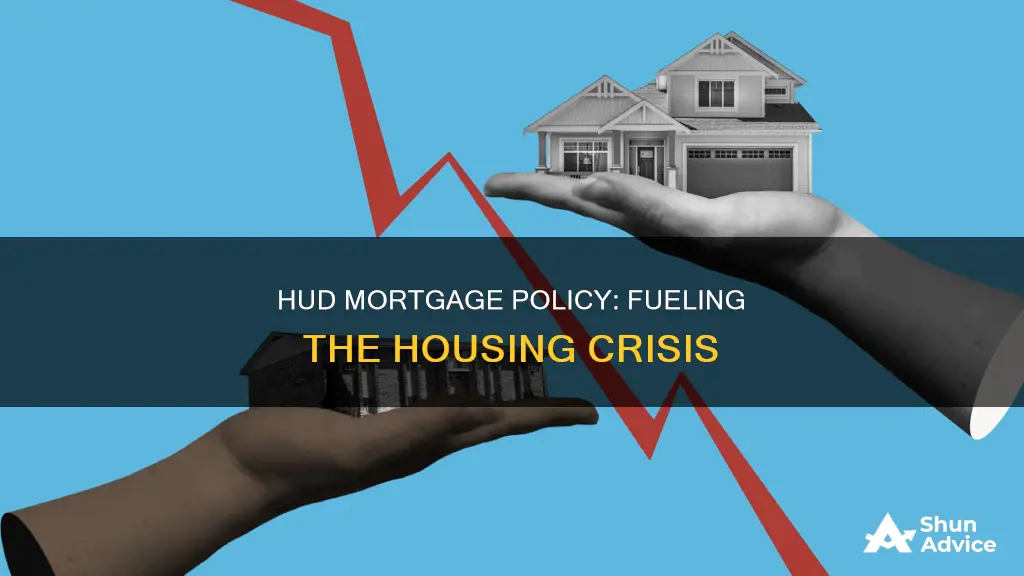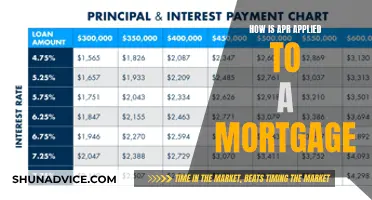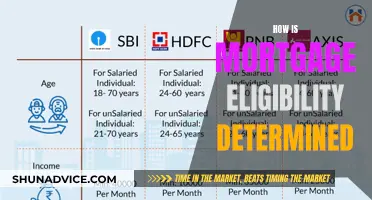
The subprime mortgage crisis of 2007–2010 was caused by a combination of factors, including the actions of the Department of Housing and Urban Development (HUD) and its affordable housing goals. HUD's policies encouraged lending to high-risk borrowers, contributing to a period of financial turmoil. The expansion of mortgages to high-risk individuals, coupled with rising house prices, resulted in a vulnerable financial system. This was further exacerbated by weak underwriting standards, unsound risk management practices, and complex financial products. While some argue that government affordable housing policies were not the primary cause, others, like Peter J. Wallison, blame US housing policy for the crisis. The National Homeownership Strategy, compiled by HUD in 1995, advocated for a relaxation of credit standards and greater involvement of state and local organizations in promoting affordable housing. These factors, along with other policy decisions, contributed to the subprime mortgage crisis.
| Characteristics | Values |
|---|---|
| Date of crisis | 2007-2010 |
| Cause of crisis | Widespread failures in financial regulation, including the Federal Reserve's failure to address the tide of toxic mortgages |
| Dramatic breakdowns in corporate governance, including financial firms acting recklessly and taking on too much risk | |
| Excessive borrowing and risk by households and Wall Street | |
| Key policymakers ill-prepared for the crisis, lacking a full understanding of the financial system they oversaw | |
| Systemic breaches in accountability and ethics at all levels | |
| Deregulation, excess regulation, and failed regulation by the federal government | |
| Weak underwriting standards | |
| Unsound risk management practices | |
| Increasingly complex and opaque financial products | |
| Excessive leverage | |
| Expansion of mortgages to high-risk borrowers | |
| Rising house prices | |
| Low-quality and high-risk loans | |
| Failure to understand the risks of investing in Fannie Mae and Freddie Mac |
What You'll Learn

The role of Fannie Mae and Freddie Mac
Fannie Mae and Freddie Mac are pivotal in the secondary mortgage market, buying and securitizing mortgages. They ensure a steady flow of mortgage credit, influencing interest rates and availability. Their government sponsorship includes an implicit guarantee and regulatory oversight by bodies like FHFA and HUD.
In the years leading up to the 2008 Financial Crisis, they started investing in riskier loans, contributing to a housing bubble. They purchased large volumes of Alt-A mortgages, which often lacked full documentation of borrowers' incomes. They also bought private-label MBS collateralized by subprime mortgages, i.e., loans issued to borrowers with poor credit ratings. Their management explicitly stated their intention to take on more risk in a 2007 presentation, and their CEOs profited handsomely from these decisions.
When the housing bubble burst in 2007, defaults surged, and the MBS market collapsed. Fannie Mae and Freddie Mac lost billions of dollars, and investor confidence in them eroded. As their stock prices plummeted, the federal government intervened to prevent a wider economic fallout, placing them under direct supervision and passing the Housing and Economic Recovery Act in July 2008.
While some argue that their actions were not the major cause of the crisis, it is clear that they played a significant role in the events leading up to and during the 2008 Financial Crisis.
Understanding Mortgage Payments: How High is Too High?
You may want to see also

The National Homeownership Strategy
The document advocated for greater involvement of state and local organisations in the promotion of affordable housing. It also promoted the use of low or no-down payment loans and second, unsecured loans to the borrower to pay their down payments and closing costs. This idea manifested in "silent second" loans that became popular in several states and cities. Using federal and their own funds, these states and cities offered borrowers loans that would defray the cost of the down payment.
While some have argued that government affordable housing policies were the major cause of the financial crisis, others, including the Financial Crisis Inquiry Commission (FCIC), Federal Reserve economists, and several academic researchers, disagree. They argue that Community Reinvestment Act loans outperformed other "subprime" mortgages and that GSE mortgages performed better than private label securitizations. They also found that HUD's affordable housing goals only marginally contributed to Fannie's and Freddie's participation in risky mortgages.
Mortgage Borrowing: When Is It Too Much?
You may want to see also

The housing bubble
In the early to mid-2000s, mortgages became more accessible to borrowers who previously would have struggled to obtain them due to below-average credit histories, small down payments, or high-payment loan requests. This expansion of credit was facilitated by the repackaging of mortgages into pools that were sold to investors, with private-label mortgage-backed securities (PMBS) providing most of the funding for subprime mortgages.
The National Homeownership Strategy, compiled by HUD Secretary Henry Cisneros in 1995, advocated for a general loosening of lending standards, particularly for affordable housing. This included the promotion of low or no-down-payment loans and the use of unsecured loans to cover down payments and closing costs. These "silent second" loans became popular in several states and cities, with governments using federal and state funds to offer borrowers loans to defray the cost of down payments.
The Federal Reserve's failure to regulate the tide of toxic mortgages contributed to the problem. Ben Bernanke, the Federal Reserve Chair, testified in September 2010 that there were structural weaknesses in the financial system, including weak underwriting standards and unsound risk management practices, that amplified the shocks of the crisis.
As the housing bubble began to deflate in mid-2007, the high-risk loans engendered by these policies started to fail in unprecedented numbers. This led to a period of turmoil in the financial markets, with losses on subprime mortgage securities and a run on the shadow banking system.
Mortgages: Understanding the High Cost of $1800 Monthly Payments
You may want to see also

High-risk mortgages
The subprime mortgage crisis of 2007–2010 was caused by the expansion of mortgages to high-risk borrowers, which was facilitated by rising house prices and weak underwriting standards. In the early to mid-2000s, high-risk mortgages became available from lenders who funded them by repackaging them into pools and selling them to investors. These lenders included private banks and government-sponsored enterprises (GSEs) such as Fannie Mae and Freddie Mac.
Fannie Mae was the biggest buyer of Countrywide's mortgages. In 2003, US Congressman Ron Paul argued that government policies encouraged lending to people who couldn't afford to pay back their loans, and he predicted that this would lead to a bailout. In his lone dissent to the FCIC, Commissioner Peter J. Wallison blamed US housing policy, including the actions of Fannie and Freddie, primarily for the crisis. He wrote that the low quality and high-risk loans generated by government policies failed in unprecedented numbers when the housing bubble began to deflate in mid-2007.
The National Homeownership Strategy, compiled in 1995 by HUD Secretary Henry Cisneros, advocated greater involvement of state and local organisations in promoting affordable housing. It also promoted the use of low or no-down-payment loans and second, unsecured loans to the borrower to pay their down payments and closing costs. This idea manifested in "silent second" loans that became popular in several states and cities, which offered borrowers loans that would defray the cost of the down payment.
The FCIC, Federal Reserve economists, and several academic researchers have argued that government affordable housing policies were not the major cause of the financial crisis. They argue that Community Reinvestment Act loans outperformed other subprime mortgages, and GSE mortgages performed better than private-label securitizations. According to the FCIC, HUD's affordable housing goals for the GSEs only contributed marginally to their participation in risky mortgages.
FICO Scores: Getting Mortgage-Ready
You may want to see also

The impact of government policies
The National Homeownership Strategy, formulated by HUD in 1995, advocated a relaxation of credit standards and greater involvement of state and local organizations in promoting affordable housing. This strategy, along with policies like the Community Reinvestment Act and HUD's affordable housing goals, has been criticized for pressuring banks to make risky loans and contributing to a breakdown in underwriting standards.
Additionally, the Federal Reserve's efforts to stabilize the housing market post-crisis may have inadvertently contributed to the problem. Their commitment to purchasing long-term securities and keeping interest rates low was intended to boost confidence and lower interest rates. However, this led to an explosion in home prices, creating one of the biggest challenges for the housing market.
While there are differing opinions on the extent to which government policies caused the crisis, it is clear that policy failures at various levels of government contributed significantly to the vulnerability of the financial system.
Homeowners Claims: Paid Without a Mortgage
You may want to see also
Frequently asked questions
The subprime mortgage crisis of 2007-2010 was a period of financial turmoil caused by the expansion of mortgages to high-risk borrowers, rising house prices, and the failure of financial regulation.
The Department of Housing and Urban Development's (HUD) affordable housing goals encouraged the expansion of mortgage credit to high-risk borrowers, including people with below-average credit histories and those seeking high-payment loans. This contributed to a housing bubble that peaked in 2005-2006 and subsequently deflated, triggering the crisis.
HUD's National Homeownership Strategy, compiled in 1995, advocated a general loosening of lending standards and the promotion of affordable housing. This included the use of low or no-down payment loans and second, unsecured loans to borrowers to cover their down payments and closing costs.
The role of government affordable housing policies in the financial crisis is debated. Some, like Commissioner Peter J. Wallison, argue that these policies were primarily responsible for the crisis by encouraging high-risk loans. However, others, including the Financial Crisis Inquiry Commission (FCIC), contend that these policies only marginally contributed to the participation of Fannie Mae and Freddie Mac in risky mortgages.
The HUD mortgage policy contributed to rising home prices and an increase in high-risk mortgages. It also led to a locked-in effect, where homeowners with super-low mortgage rates try to hold on to their mortgages for as long as possible, depressing home sales and impacting the brokerage and mortgage-lending industries.







